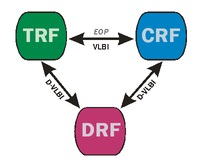 The
goal of this project is the realization of frame ties between the
dynamic reference frames of space probes like satellites, spacecrafts,
the Moon or other planetary bodies, the kinematically defined
Inter-national Celestial Reference Frame (ICRF) consisting of precise
coordinates of extragalactic radio sources (radio galaxies or quasars),
and the International Terrestrial Reference Frame (ITRF) realized on
Earth. This can be done best by using the differential Very Long
Baseline Interferometry (D-VLBI) method, connecting a space probe to a
close-by quasar by alternately observing signals of those two sources.
Although NASA, ESA, and JAXA have already successfully used D-VLBI
observations on some of their space missions, all three agencies follow
different strategies and just opened up the great possibilities of
D-VLBI. In the project, a general concept for future applications will
be presented. The newly developed Vienna VLBI Software (VieVS) will be
expanded by the possibility of processing D-VLBI data and providing
results that can be used to determine and link the different reference
frames. Detailed simulations will lead to profound knowledge on D-VLBI
itself, especially with regard to future signal structure and
observation configuration. At the end of the first three years of the
project we will be able to process real measurement data from current
and upcoming space missions, an important step towards the determination
of the ties in question on a routine basis needed for all kinds of
navigation in space.
The
goal of this project is the realization of frame ties between the
dynamic reference frames of space probes like satellites, spacecrafts,
the Moon or other planetary bodies, the kinematically defined
Inter-national Celestial Reference Frame (ICRF) consisting of precise
coordinates of extragalactic radio sources (radio galaxies or quasars),
and the International Terrestrial Reference Frame (ITRF) realized on
Earth. This can be done best by using the differential Very Long
Baseline Interferometry (D-VLBI) method, connecting a space probe to a
close-by quasar by alternately observing signals of those two sources.
Although NASA, ESA, and JAXA have already successfully used D-VLBI
observations on some of their space missions, all three agencies follow
different strategies and just opened up the great possibilities of
D-VLBI. In the project, a general concept for future applications will
be presented. The newly developed Vienna VLBI Software (VieVS) will be
expanded by the possibility of processing D-VLBI data and providing
results that can be used to determine and link the different reference
frames. Detailed simulations will lead to profound knowledge on D-VLBI
itself, especially with regard to future signal structure and
observation configuration. At the end of the first three years of the
project we will be able to process real measurement data from current
and upcoming space missions, an important step towards the determination
of the ties in question on a routine basis needed for all kinds of
navigation in space.